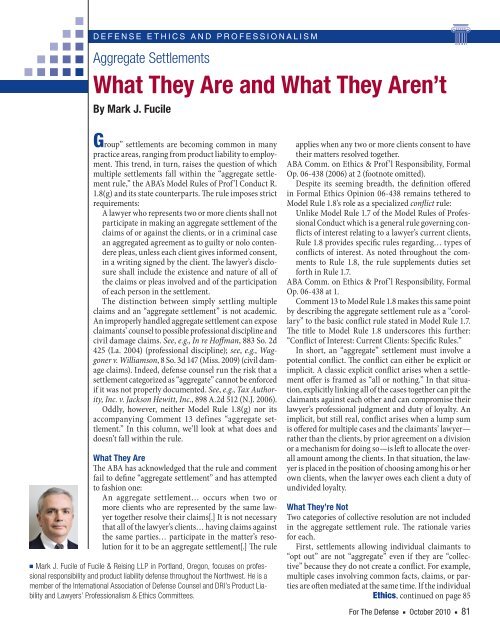For The Defense, October 2010 - DRI Today
For The Defense, October 2010 - DRI Today
For The Defense, October 2010 - DRI Today
You also want an ePaper? Increase the reach of your titles
YUMPU automatically turns print PDFs into web optimized ePapers that Google loves.
D E F E N S E E T H I C S A N D P R O F E S S I O N A L I S MAggregate SettlementsWhat <strong>The</strong>y Are and What <strong>The</strong>y Aren’tBy Mark J. FucileGroup” settlements are becoming common in manypractice areas, ranging from product liability to employment.This trend, in turn, raises the question of whichmultiple settlements fall within the “aggregate settlementrule,” the ABA’s Model Rules of Prof’l Conduct R.1.8(g) and its state counterparts. <strong>The</strong> rule imposes strictrequirements:A lawyer who represents two or more clients shall notparticipate in making an aggregate settlement of theclaims of or against the clients, or in a criminal casean aggregated agreement as to guilty or nolo contenderepleas, unless each client gives informed consent,in a writing signed by the client. <strong>The</strong> lawyer’s disclosureshall include the existence and nature of all ofthe claims or pleas involved and of the participationof each person in the settlement.<strong>The</strong> distinction between simply settling multipleclaims and an “aggregate settlement” is not academic.An improperly handled aggregate settlement can exposeclaimants’ counsel to possible professional discipline andcivil damage claims. See, e.g., In re Hoffman, 883 So. 2d425 (La. 2004) (professional discipline); see, e.g., Waggonerv. Williamson, 8 So. 3d 147 (Miss. 2009) (civil damageclaims). Indeed, defense counsel run the risk that asettlement categorized as “aggregate” cannot be enforcedif it was not properly documented. See, e.g., Tax Authority,Inc. v. Jackson Hewitt, Inc., 898 A.2d 512 (N.J. 2006).Oddly, however, neither Model Rule 1.8(g) nor itsaccompanying Comment 13 defines “aggregate settlement.”In this column, we’ll look at what does anddoesn’t fall within the rule.What <strong>The</strong>y Are<strong>The</strong> ABA has acknowledged that the rule and commentfail to define “aggregate settlement” and has attemptedto fashion one:An aggregate settlement… occurs when two ormore clients who are represented by the same lawyertogether resolve their claims[.] It is not necessarythat all of the lawyer’s clients… having claims againstthe same parties… participate in the matter’s resolutionfor it to be an aggregate set tle ment[.] <strong>The</strong> ruleapplies when any two or more clients consent to havetheir matters resolved together.ABA Comm. on Ethics & Prof’l Responsibility, <strong>For</strong>malOp. 06-438 (2006) at 2 (footnote omitted).Despite its seeming breadth, the definition offeredin <strong>For</strong>mal Ethics Opinion 06-438 remains tethered toModel Rule 1.8’s role as a specialized conflict rule:Unlike Model Rule 1.7 of the Model Rules of ProfessionalConduct which is a general rule governing conflictsof interest relating to a lawyer’s current clients,Rule 1.8 provides specific rules regarding… types ofconflicts of interest. As noted throughout the commentsto Rule 1.8, the rule supplements duties setforth in Rule 1.7.ABA Comm. on Ethics & Prof’l Responsibility, <strong>For</strong>malOp. 06-438 at 1.Comment 13 to Model Rule 1.8 makes this same pointby describing the aggregate settlement rule as a “corollary”to the basic conflict rule stated in Model Rule 1.7.<strong>The</strong> title to Model Rule 1.8 underscores this further:“Conflict of Interest: Current Clients: Specific Rules.”In short, an “aggregate” settlement must involve apotential conflict. <strong>The</strong> conflict can either be explicit orimplicit. A classic explicit conflict arises when a settlementoffer is framed as “all or nothing.” In that situation,explicitly linking all of the cases together can pit theclaimants against each other and can compromise theirlawyer’s professional judgment and duty of loyalty. Animplicit, but still real, conflict arises when a lump sumis offered for multiple cases and the claimants’ lawyer—rather than the clients, by prior agreement on a divisionor a mechanism for doing so—is left to allocate the overallamount among the clients. In that situation, the lawyeris placed in the position of choosing among his or herown clients, when the lawyer owes each client a duty ofundivided loyalty.What <strong>The</strong>y’re NotTwo categories of collective resolution are not includedin the aggregate settlement rule. <strong>The</strong> rationale variesfor each.First, settlements allowing individual claimants to“opt out” are not “aggregate” even if they are “collective”because they do not create a conflict. <strong>For</strong> example,multiple cases involving common facts, claims, or par-n Mark J. Fucile of Fucile & Reising LLP in Portland, Oregon, focuses on professionalresponsibility and product liability defense throughout the Northwest. He is amember of the International Association of <strong>Defense</strong> Counsel and <strong>DRI</strong>’s Product Liabilityand Lawyers’ Professionalism & Ethics Committees. Ethics, continued on pageties are often mediated at the same time. If the individual85<strong>For</strong> <strong>The</strong> <strong>Defense</strong> n <strong>October</strong> <strong>2010</strong> n 81
















